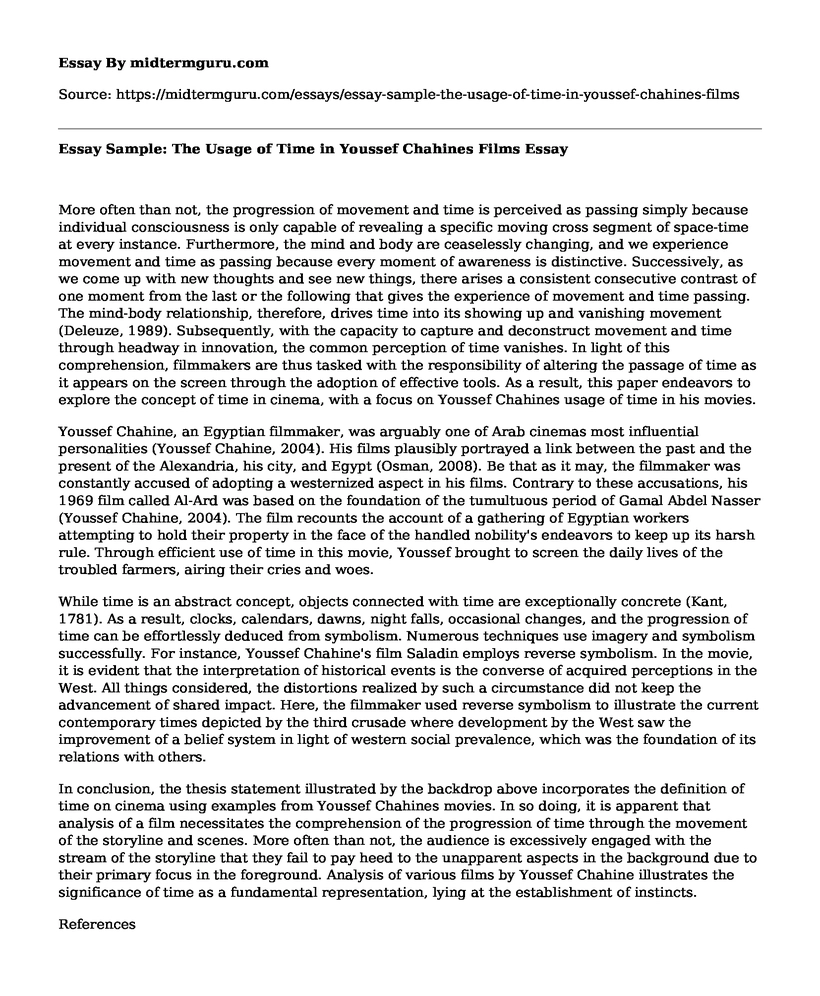More often than not, the progression of movement and time is perceived as passing simply because individual consciousness is only capable of revealing a specific moving cross segment of space-time at every instance. Furthermore, the mind and body are ceaselessly changing, and we experience movement and time as passing because every moment of awareness is distinctive. Successively, as we come up with new thoughts and see new things, there arises a consistent consecutive contrast of one moment from the last or the following that gives the experience of movement and time passing. The mind-body relationship, therefore, drives time into its showing up and vanishing movement (Deleuze, 1989). Subsequently, with the capacity to capture and deconstruct movement and time through headway in innovation, the common perception of time vanishes. In light of this comprehension, filmmakers are thus tasked with the responsibility of altering the passage of time as it appears on the screen through the adoption of effective tools. As a result, this paper endeavors to explore the concept of time in cinema, with a focus on Youssef Chahines usage of time in his movies.
Youssef Chahine, an Egyptian filmmaker, was arguably one of Arab cinemas most influential personalities (Youssef Chahine, 2004). His films plausibly portrayed a link between the past and the present of the Alexandria, his city, and Egypt (Osman, 2008). Be that as it may, the filmmaker was constantly accused of adopting a westernized aspect in his films. Contrary to these accusations, his 1969 film called Al-Ard was based on the foundation of the tumultuous period of Gamal Abdel Nasser (Youssef Chahine, 2004). The film recounts the account of a gathering of Egyptian workers attempting to hold their property in the face of the handled nobility's endeavors to keep up its harsh rule. Through efficient use of time in this movie, Youssef brought to screen the daily lives of the troubled farmers, airing their cries and woes.
While time is an abstract concept, objects connected with time are exceptionally concrete (Kant, 1781). As a result, clocks, calendars, dawns, night falls, occasional changes, and the progression of time can be effortlessly deduced from symbolism. Numerous techniques use imagery and symbolism successfully. For instance, Youssef Chahine's film Saladin employs reverse symbolism. In the movie, it is evident that the interpretation of historical events is the converse of acquired perceptions in the West. All things considered, the distortions realized by such a circumstance did not keep the advancement of shared impact. Here, the filmmaker used reverse symbolism to illustrate the current contemporary times depicted by the third crusade where development by the West saw the improvement of a belief system in light of western social prevalence, which was the foundation of its relations with others.
In conclusion, the thesis statement illustrated by the backdrop above incorporates the definition of time on cinema using examples from Youssef Chahines movies. In so doing, it is apparent that analysis of a film necessitates the comprehension of the progression of time through the movement of the storyline and scenes. More often than not, the audience is excessively engaged with the stream of the storyline that they fail to pay heed to the unapparent aspects in the background due to their primary focus in the foreground. Analysis of various films by Youssef Chahine illustrates the significance of time as a fundamental representation, lying at the establishment of instincts.
References
BIBLIOGRAPHY Cinema of the World. (2011). Youssef Chahine Al-ard aka The Land (1969). Retrieved from Cinema of the World: http://worldscinema.org/2012/04/youssef-chahine-al-ard-aka-the-land-1969/
Deleuze, G. (1989). The Time-Image: Cinema 2. Minneapolis: University of Minnesota Press.
Haydock, N., & Risden, E. L. (2009). Hollywood in the Holy Land: Essays on Film Depictions of the Crusades and Christian-Muslim Clashes. McFarland.
Kant, I. (1781). Critique of Pure Reason.
Osman, T. (2008, July 30). Youssef Chahine, the life-world of film. Retrieved from OpenDemocracy: https://www.opendemocracy.net/article/art_culture/film/youssef-chahine-the-life-world-of-film
Youssef Chahine. (2004). Retrieved from Encyclopedia of World Biography: http://www.encyclopedia.com/history/encyclopedias-almanacs-transcripts-and-maps/chahine-youssef
Cite this page
Essay Sample: The Usage of Time in Youssef Chahines Films. (2021, May 21). Retrieved from https://midtermguru.com/essays/essay-sample-the-usage-of-time-in-youssef-chahines-films
If you are the original author of this essay and no longer wish to have it published on the midtermguru.com website, please click below to request its removal:
- Essay on China Through the Looking Glass Exhibition
- Essay on IMAX Theaters of High Quality Films
- Paper Example of Questions on Film Studies
- The Photographic Vision on Light - Essay Sample
- Essay Sample on Writing Process
- Essay Sample on Frida Kahlo and Robert Frost Artworks
- Research Paper on History of Music







